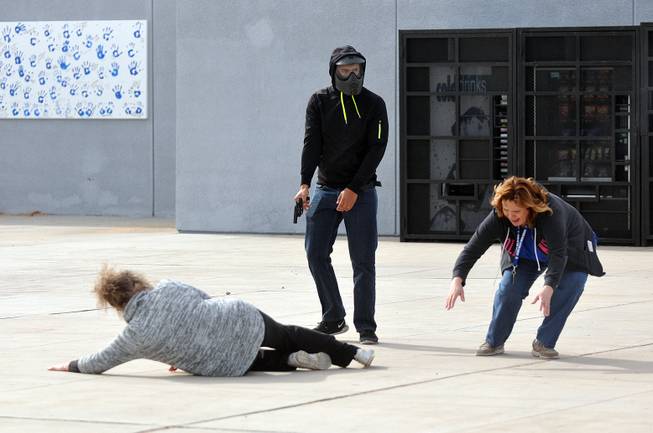
David Pardo / The Victor Valley Daily Press via AP
San Bernardino County Sheriff Department, Barstow Police Department and California Highway Patrol conducted an active shooter drill at Silver Valley High School in Yermo, Calif. on Wednesday, Jan. 27, 2016.
Wednesday, Feb. 12, 2020 | 2 a.m.
View more of the Sun's opinion section
Active shooter drills in schools are an example of a well-intended idea producing unintended results. Instead of making kids feel more secure, the drills often leave them traumatized and feeling less safe at school.
That being the case, schools everywhere should read a new white paper on the subject from Everytown for Gun Safety in partnership with the American Federation of Teachers and the National Education Association, the two largest teachers unions in the nation.
Amid mounting evidence of students experiencing anxiety, depression, sleeplessness and worsening school performance due to these exercises, the groups offer a set of guidelines that are designed to keep classrooms safe while also shielding children from trauma.
The foremost recommendation calls for an end to live drills involving students in favor of training for faculty and staff on how to respond to active shooter situations. That includes instruction on lockout and evacuation procedures, as well as providing emergency medical care.
It’s a wise suggestion. But unfortunately, as Everytown for Gun Safety and its union partners acknowledge, schools in the majority of states can’t follow it because state laws require them to conduct lockdown drills involving students. For schools facing those legal requirements — Nevada is among them — the group’s recommendations include:
• Doing away with simulated shootings
• Providing parents with notice of the drills, and announcing them to students and educators before they commence
• Working with staff and school-based mental health professionals to develop exercises that are age-appropriate
• Ensuring that efforts to address students’ emotional and physical well-being are part of any exercises.
These are all responsible recommendations, and we’d urge schools to follow them.
Although the Clark County School District didn’t immediately reply to questions about its policies, we’re confident the district will examine the report and follow its guidelines (if the district doesn’t already have them in place).
There shouldn’t be any conflict with the state law, which gives districts discretion on the type of drills that must be conducted.
But based on anecdotal evidence across the nation, it’s clear that simulations staged without warning must be eliminated. In schools that have conducted them, students and parents have described panic breaking out due to confusion over whether the situation is a drill. In other cases, pre-kindergarten students as young as 3 years old have been confined for extended periods during simulations despite their inability to comprehend what’s real and what’s not.
“It’s psychologically distressing for a young child to practice active shooters coming into your area,” a psychiatrist at Texas Children’s Hospital in Houston says in the report. “The younger the child, the less likely they are to understand that an act of violence is not occurring during the drill.”
Physical harm has resulted, as well. At an elementary school in Indiana, law enforcement officers for some reason lined up educators against a wall and shot them in the back with airsoft rifles that left painful welts.
Meanwhile, there’s little if any evidence that the training is making schools safer. That’s partly because schools are a relatively safe place for kids — just 0.2% of the 36,000 gun deaths per year in the U.S. happened on school grounds, and a recent study showed that three of four children killed in mass shootings over the past decade died in their homes as victims of domestic violence. So you really have to question the emotional costs of subjecting millions of kids to lockdown drills on a regular basis against the effects of those exercises.
In contrast, the few studies that have been conducted suggest that students learn more about preparedness when they’re not being frightened but instead are simply given information or are drilled in a nontraumatic way.
So it’s time to recognize that despite the good intentions behind active shooter drills, they need to be tailored to stop hurting our kids more than helping them.
To read the report, visit everytownresearch.org/school-safety-drills.
